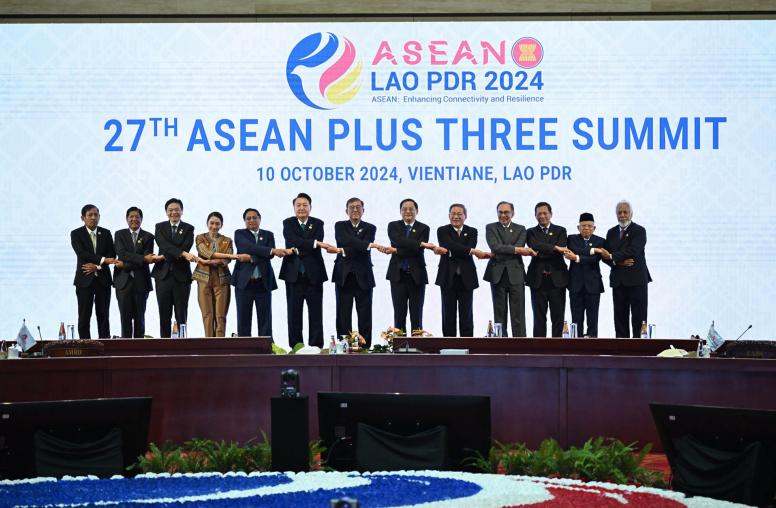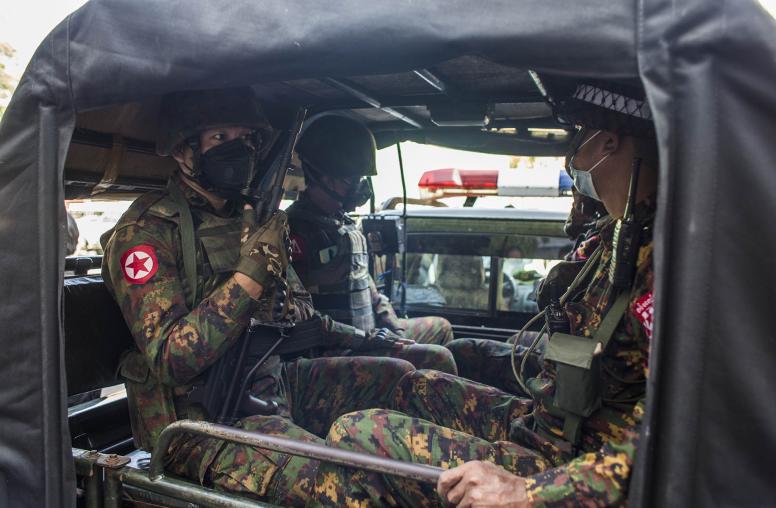Like Ukraine, Myanmar Deserves International Aid
The resistance’s historic unity for democratic change is worthy of the world’s support.
Lt. Gen. Sumlut Gun Maw is the vice chairman of the Kachin Independence Council. Yee Mon is the minister of defense of the National Unity Government. Min Ko Naing is one of Myanmar's most prominent activists and a former student leader of the renowned 8888 movement.
Over decades of brutal military rule, Myanmar’s generals have sometimes shifted tactics but relied on one consistent strategy to ensure their grip on power — fomenting divisions within the population and fueling intercommunal violence. That repeated ploy finally failed in the upheaval that followed the 2021 coup. Today, the country has embraced an historic unity that brings together virtually every ethnic and political strand to oppose the ruling junta. Like Ukrainians, Myanmar's people are courageous, spirited and united, and willing to make great sacrifice in their fight for democracy. Unlike Ukrainians, they are not receiving the kind of assistance that could help shorten a war of liberation to months rather than years. Even a small fraction of the aid Ukraine has gotten to repel Russian aggression could dramatically affect the struggle to unseat Myanmar’s military dictators.

The unprecedented unity in Myanmar, spurred by the coup and its brutal power grab, is exemplified by the solidarity of the various organizations that we represent: an ethnic armed group, the National Unity Government (NUG) and the pro-democratic 8888 generation group. Each of these groups helps lead today’s groundbreaking multi-ethnic resistance movement.
Almost immediately after the coup in February 2021, diverse elements of the population — elected leaders, political parties, civil society groups of all kinds, ethnic minority organizations, striking civil servants — joined hands to establish a complex structure of interim governance to guide a revolutionary movement that aims to establish a new federal democracy.
Within a few months, a combination of de jure and de facto representatives of the National Unity Consultative Council and Committee Representing the Pyidaungsu Hluttaw formed the NUG to guide the resistance structure. The resistance movement has been steadily fostering unity and cohesion by engaging in inter-resistance dialogue, bringing together individuals from diverse ethnic and religious backgrounds, spanning generations, regions and walks of life. To this end, a “Federal Democracy Charter” has been produced to lay the foundation for the state that we aim to achieve upon victory — a “peaceful federal democratic union that guarantees freedom, justice and equality.”
The Coup Regime’s War on Myanmar
In the meantime, we are up against a regime of boundless cruelty at war with its own people. A recent example: On the morning of April 11, 2023, a deafening cacophony of explosions woke the secluded mid-country village of Pazigyi into a hellish chaos. Fighter jets and helicopters hovered overhead, unleashing a merciless barrage of bombs and gunfire on a gathering of villagers below. Hundreds of bodies were strewn across the area, leaving the whole nation reeling in shock and pain. But the atrocities did not end. Another round of aerial gunfire continued the slaughter, targeting rescue workers and destroying evidence.
This tragedy is far from an isolated incident. In the two and a half years since the coup, the military has killed thousands of civilians, detained tens of thousands — including senior elected officials, such as State Counsellor Aung San Suu Kyi — demolished thousands of homes in arson attacks and launched hundreds of air strikes against civilian targets. Both the majority Bamar-populated central plain and minority ethnic areas are targets for having resisted the generals’ attempts to retake power against the people’s will.
While resistance to the military takeover began with peaceful protests in spring 2021, it soon turned to armed defense against the generals’ violent response. The popular movement to restore civilian rule quickly transformed into a nationwide revolution to forge a new path toward an inclusive federal democratic nation free of military control — a goal that has eluded Burma since its early days of independence in 1948.
With the turn to armed self-defense, several powerful ethnic armed organizations joined forces with young people across the country to help them form and train People’s Defense Forces (PDFs) aimed at protecting civilians from the military and overthrowing the junta.
The Armed Opposition to the Junta Is Advancing
The NUG's Ministry of Defense, at the center of the armed resistance, collaborates closely with the two largest ethnic armed organizations fighting the junta, the, Kachin Independence Army and Karen National Union. We have established a Joint Central Command, and we are working in strategic partnership with at least eight other ethnic armed organizations — including the Karenni and Chin — to coordinate military operations and commands. We have successfully developed a deeper understanding and strengthened cooperation with other ethnic armed organizations that have been engaged in the fight against the military and actively supporting the resistance movement.
The PDFs and their alliance with long-standing ethnic armed organizations are a testament to the resilience and resolve of the Myanmar people in their fight for democracy and freedom in defiance of the overwhelming air power and resources of the Myanmar military.
Most importantly, this unprecedented unity means there is a window of opportunity for victory. The junta’s terrorist tactics are failing on all fronts, military and political. For them, it has become an existential battle. For us, this is our last, best chance at seeing a future for Myanmar free from the darkness and cancerous tumor that is the military.
Together, with the support and participation of the public, we are advancing. The National Unity Government’s PDFs, with the support and participation of the public, have effectively established their presence in numerous rural areas of the country, particularly in Sagaing and Magway Regions of central Myanmar, home to the majority Burman ethnic group and considered to be the heartland of the country with historical, strategic and socio-economic importance.
In a similar vein, ethnic armed organizations are exerting stronger and more effective governance over their traditional territories and expanding their spheres of control. Combined, NUG and ethnic organizations control at least half of the country’s territory as the coup leader General Min Aung Hlaing himself has admitted.
Sharing a common enemy in military rule and the common goal of building a federal democracy under civilian governance, the entire nation is committed firmly to achieving success. The people of Myanmar march with one voice and united effort.
In doing so, Myanmar people working as domestic help in foreign countries regularly contribute their entire salaries to our revolution. Elderly mothers from upper Myanmar are donating their last pair of earrings, even as their lands are set ablaze by the junta. In self-defense, we rose up armed with nothing but homemade Tumi guns and whatever we could scrounge together from scrap metal. Despite facing the junta’s automatic weapons and the latest fighter jets from Russia, we have them on the ropes. Just as Kyiv prepares to launch a counteroffensive to retake lost territory, the people of Myanmar fight for every inch of land stolen by the junta.
Myanmar’s Struggle — and Ukraine’s
But a swift victory will require the support and assistance of the international community and in this, we cannot compare ourselves to Ukrainians. We have received very little in the way of materiel support. A mere 1 percent of the aid going to Ukraine would prove instrumental in the Myanmar revolution’s ability to achieve a decisive victory in a matter of months instead of the years-long struggle we face against such lopsided combat power.
The current resistance movement is unique in Myanmar’s history and worthy of international support. With our pan-ethnic unity of purpose, unwavering belief in democracy and commitment to the cause, this is the best — and perhaps last — chance, after seven decades of unending war, to bring peace, democracy and freedom to Myanmar.
Regardless of the support we get from the international community, the Myanmar people will not waver in their determined struggle against the military dictatorship. However, if international support reinforces the struggle, the will of the people is sure to triumph over the military dictatorship in a shorter time span, leading to a swifter emergence of a peaceful federal democratic union and the restoration of stability in both the country and the region.



